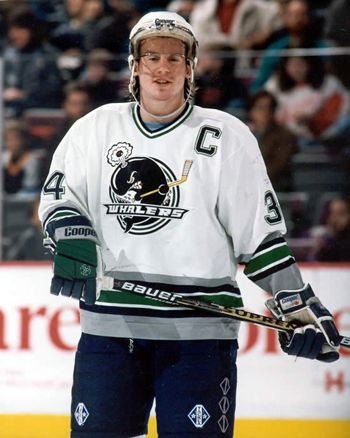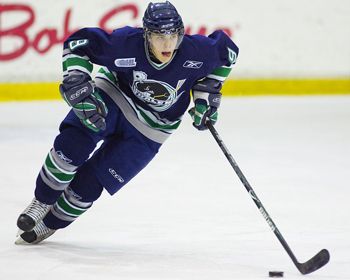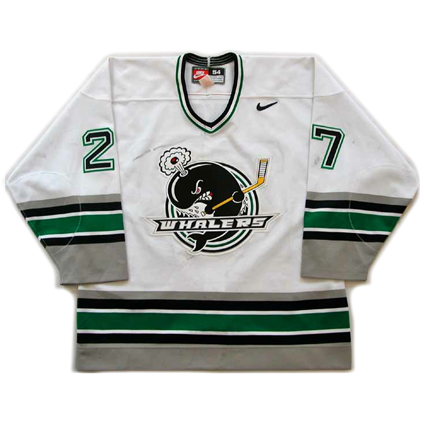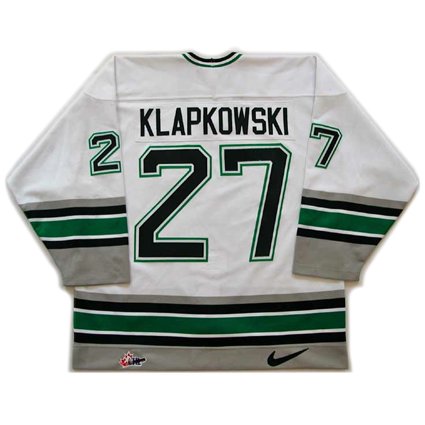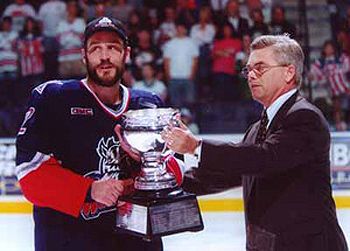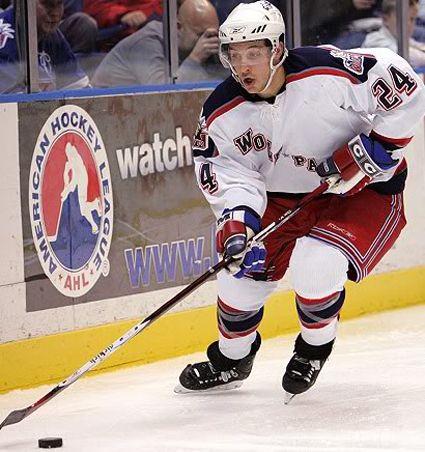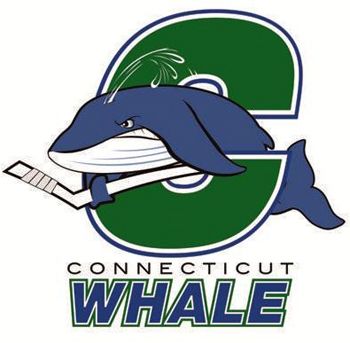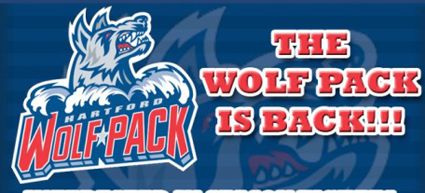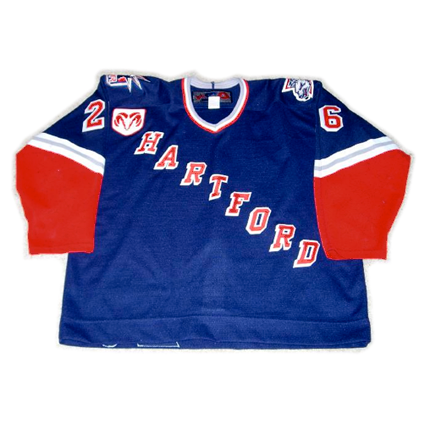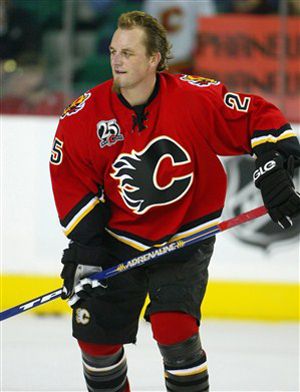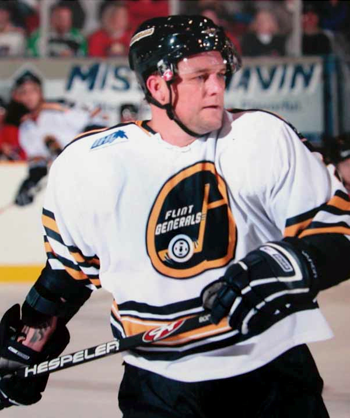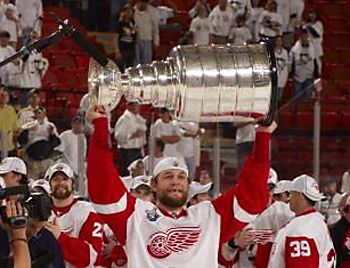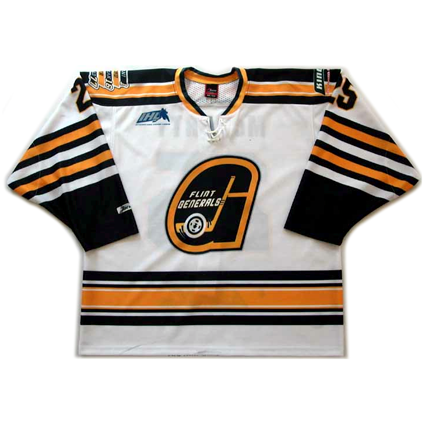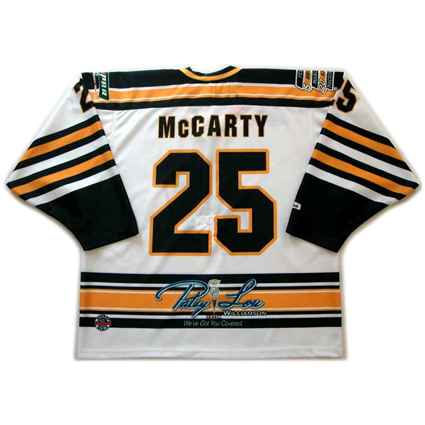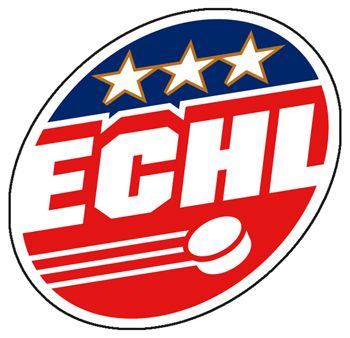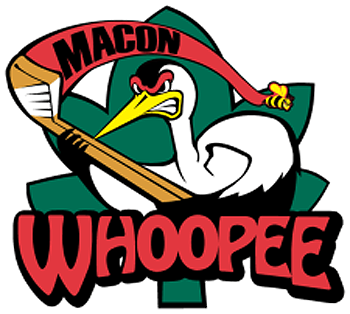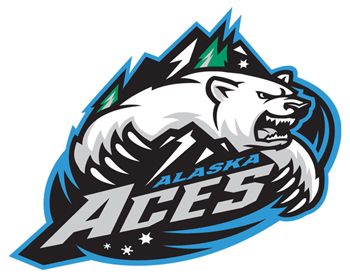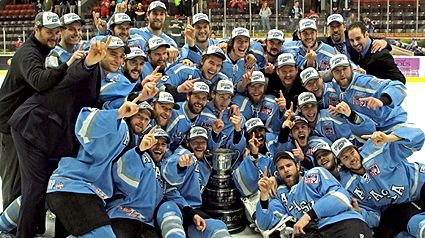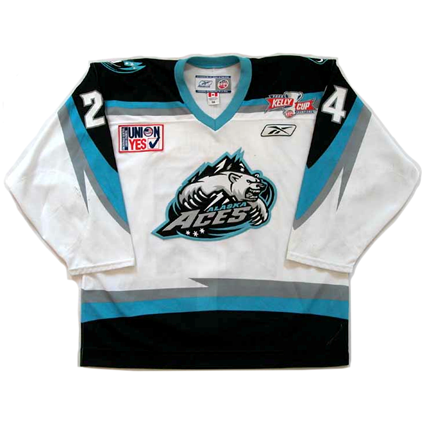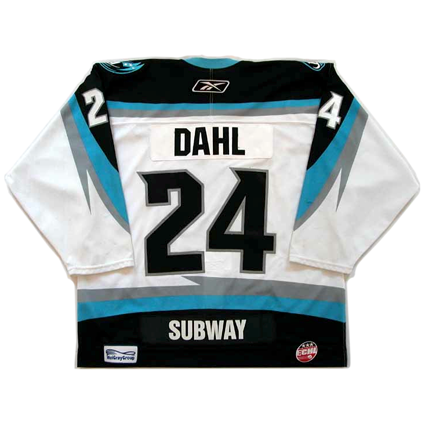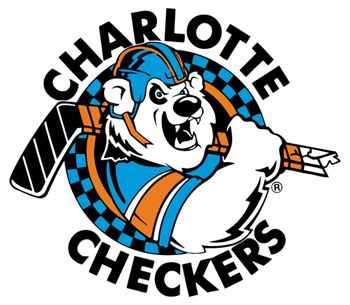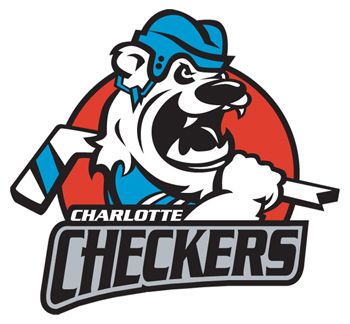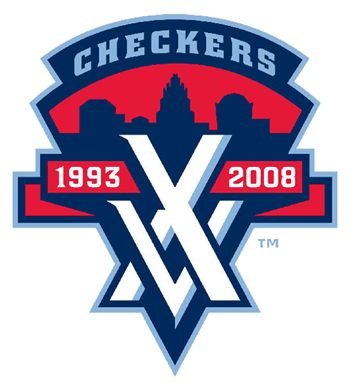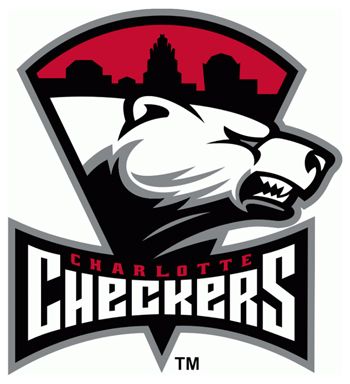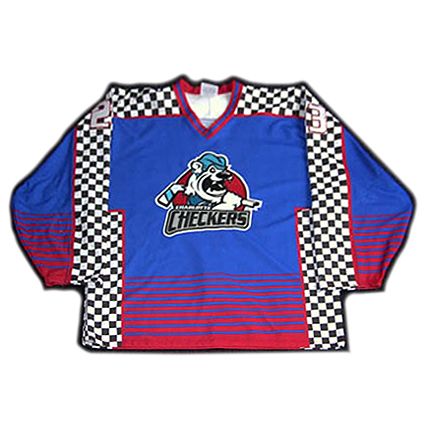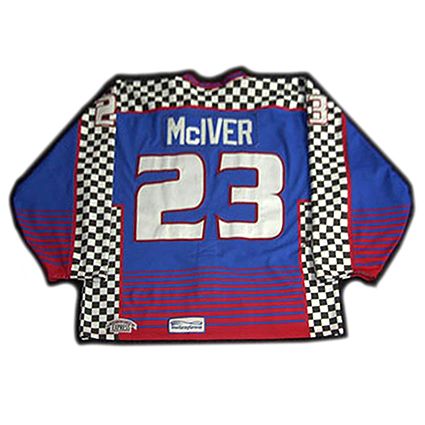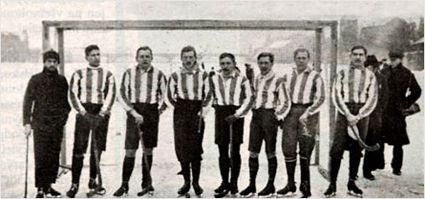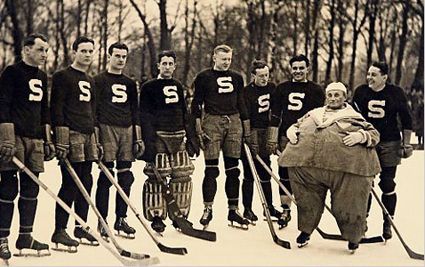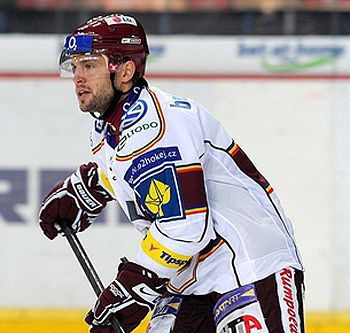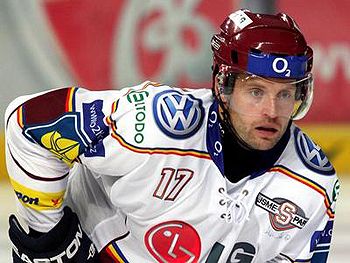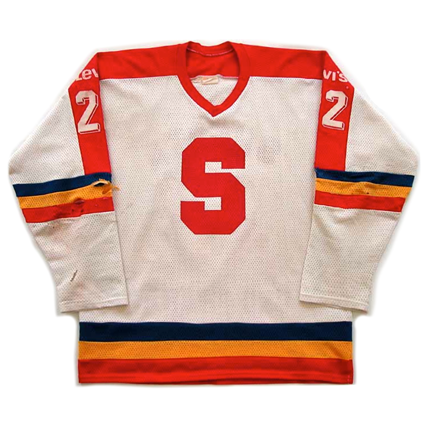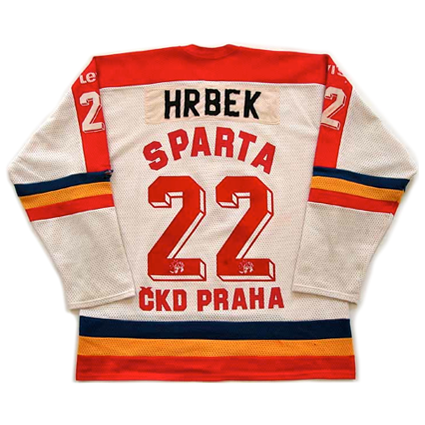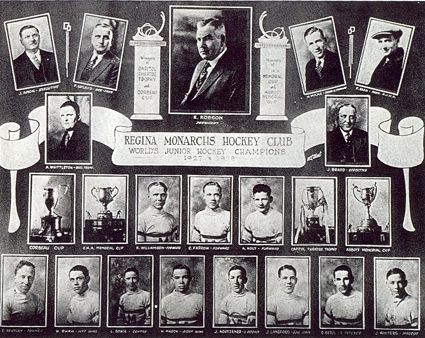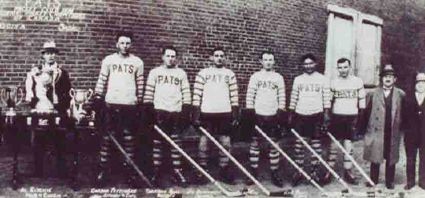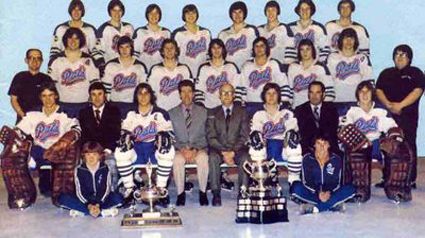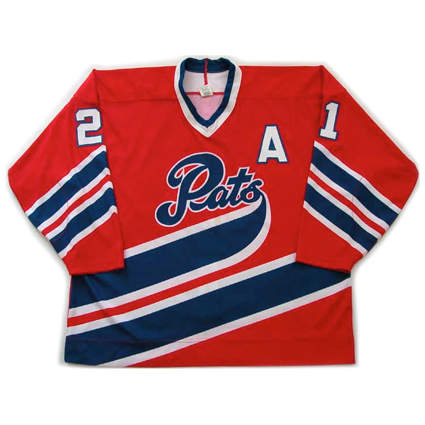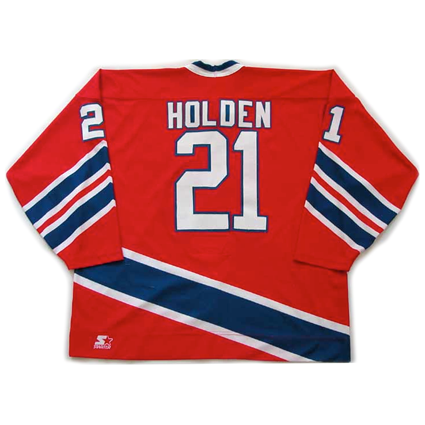July by the Numbers crosses to the other side of Michigan for jersey #27.
Saturday, July 27, 2013
2002-03 Plymouth Whalers Gary Klapkowski Jersey
July by the Numbers crosses to the other side of Michigan for jersey #27.
The Detroit Compuware Ambassadors were formed as an expansion team in the Ontario Hockey League for the 1990-91 season and would finish dead last with just 11 wins. After one more season they were renamed the Detroit Junior Red Wings and their fortunes improved from 27 wins to 37 to 42 and then 44 as the club won two division titles as well as the 1995 OHL playoffs to advance to their first Memorial Cup, making it all the way to the championship final and setting attendance records during the NHL lockout of 1995 in the process.
Club owner Peter Karmanos had been unsuccessful in his attempt to buy the NHL's Detroit Red Wings and instead purchased the Hartford Whalers in 1994, which led to the OHL club being renamed the Detroit Whalers. As a result of friction between the owner of the Detroit Red Wings and Karmanos following the failed deal to purchase the Detroit Red Wings, the Whalers moved out of Joe Louis Arena and up to the Palace of Auburn Hills for 1995-96. For the following season, Karmanos built his team a new home in Plymouth Township in time for the 1996-97 season.
For the 1997-98 season, the team was once again renamed, this time to the Plymouth Whalers. The Whalers then rose to new heights beginning with the 19998-99 season when they finished first overall in the OHL with 108 points and repeated the feat in 1999-00 with a league best 95 points. A second overall finish in 2000-01 gave the Whalers their third consecutive division title and they returned to the top of the heap once again in 2001-02 with 92 points. The Whalers kept their foot on the gas for their record tying fifth consecutive division title in 2002-03 with a 97 point season, their fifth over 90 points.
After winning another division title in a decidedly weak West Division in 2005-06 with just 75 points, the Whalers reloaded for the 2006-07 season. Led by Evan Brophey's 107 points and the goaltending duo of Michal Neuvirth (26 wins) and Jeremy Smith (23), the Whalers once again won the West Division with 103 points, one back of the league leading London Knights.
In the OHL playoffs, London and Plymouth advanced to the Western Conference Finals as expected and Plymouth dominated with a 4 games to 1 win before downing the Sudbury Wolves 4-2 to win the Robertson Cup and claim their place in the Memorial Cup for the second time in franchise history where they placed third.
Several Whalers have been drafted high in the NHL Entry Draft, with Bryan Berard taken first overall in 1995 when the club was known as the Jr. Red Wings leading the list.
Bryan Berard
David Legwand (1998) and Tyler Seguin (2010) were both selected second overall and Stephen Weiss at fourth overall in 2001 completing the list of top four picks from the Whalers. Seguin became the first Whaler to lead the OHL in scoring with his 106 points in 2009-10, which which was equalled by Taylor Hall of the rival Windsor Spitfires for the top spot.
Tyler Seguin
Other notable franchise alumni include Fred Brathwaite, Eric Cairns, Paul Mara, James Neal, Justin Williams and James Wisniewski, while Pat Peake is the only player in franchise history to have his number retired by the team.
Today's featured jersey is a 2002-03 Plymouth Whalers Gary Klapkowski jersey from the Whalers record season during which they won their fifth consecutive division title.
Being a part of the Hartford Whalers family, since they share the same owner, the Plymouth Whalers used the Hartford Whalers jersey template years after Hartford relocated to North Carolina to become the Hurricanes.
Today's video feature is highlights from the Plymouth Whalers taking on their rivals the Windsor Spitfires in a exciting OHL contest featuring lots of goals and fists. The two club's rinks are located just 30 miles apart and Windsor, Ontario is actually the only Canadian city located directly south of an American city.
Here is a profile on the Whalers Tyler Seguin, the second pick in the 2010 NHL Entry Draft.
Labels:
Plymouth Whalers
Friday, July 26, 2013
2003-04 Hartford Wolf Pack Bryce Lampman Jersey
July by the Numbers travels east for jersey #26.
Today's featured jersey is a 2003-04 Hartford Wolf Pack Bryce Lampman jersey. While many minor league teams have their own unique jersey sets, completely separate from their parent club, others adopt the look of their NHL big brothers, sometimes with very poor results aesthetically.
When the Hartford Whalers of the NHL departed for North Carolina to become the Carolina Hurricanes, the New York Rangers immediately sized the opportunity to immediately fill the void of professional hockey in Hartford with the relocation of the Binghamton Rangers of the AHL for he 1997-98 season.
It was a time when minor league franchises began to realize the value of having their own unique identities, rather than simply adopting the name of their parent club, as had long been the case for many clubs, particularly those in minor league baseball. This opened the door for an increase in revenues from selling their own branded merchandise, such as caps, shirts and jerseys, and creating a stronger connection with their local fanbase, as they could now avoid having to change their name on a periodic basis as their affiliations evolved over time.
With the new approach to independent name for minor league clubs, the franchise was christened the Hartford Wolf Pack for the 1997-98 season following a name the team contest, with the name Wolf Pack being a reference to a class of submarines, as Connecticut is home to the main builder of submarines as well as the US Navy's primary submarine base.
The club got off to a strong start in Hartford, totaling 99 points in their first season as well as making it to the Calder Cup Semifinals in their first try.
Two seasons later the Wolf Pack led the AHL with a 49-22-7-2 record to lead the league with 107 points as goaltenders Milan Hnilicka and Jean-Francois Labbe combined to hold opponents to just 198 goals, the only team to allow less than 200. The Wolf Pack then eliminated Springfield, Worcester and Providence to reach the finals, where they defeated the Rochester Americans to capture the Calder Cup in their third season in Hartford as Derek Armstrong was named the playoff MVP.
Ken Gernander accepts the 2004 Calder Cup
With a strong supply of players from the Rangers organization, the Wolf Pack was a consistently strong club, with just one season with less than 95 points over the next nine seasons, which included winning Atlantic Division titles in 2003-04 and 2008-09, including four seasons of over 100 points, with their 110 points in 2007-08 setting a team record, thanks to 50 wins in 80 games.
Playoff success would remain elusive however, with first or preliminary round exits in 2001, 2003, 2005, 2007-2009 and only one trip to the semifinals in 2004, which came up short in a seventh game.
Their average attendance their first two seasons in Hartford was 7,100 compared to 12,500 during the final few seasons of the Whalers. Despite the continued and consistent competitive level of play, their attendance numbers were one long, slow nearly uninterrupted decline, drifting down from 7,100 the year following their championship to 6,700 to 5,800 by 2003. It sank to 4,500 in 2007 and 4,188 in 2009-10 after which the club was sold to Whalers Sports and Entertainment.
Bizarrely, the team started the 2010-11 season still known as the Hartford Wolf Pack, playing 22 games from early October until their return from a five game road trip when the club was re-branded as the Connecticut Whale beginning with their game on November 27th against Bridgeport!
The highly unusual mid-season name (and color) change brought to an end the team's 13 1/4 seasons as the Wolf Pack, leaving behind a history of competitive play and excellent jerseys.
But then something most unusual took place again, as the ownership group who changed the name to The Whale were out after 2 3/4 seasons and it was announced that the franchise would be reverting back to the Hartford Wolf Pack name beginning with the upcoming 2013-14 season!
Despite the turmoil of the change in ownership and name, the Wolf Pack franchise is actually the oldest continuously operating minor league franchise in North America, as they can trace their lineage back to their formation as the Providence Reds in 1926. This also makes them older than all other professional hockey franchises except the Montreal Canadiens, Toronto Maple Leafs and Boston Bruins.
But then something most unusual took place again, as the ownership group who changed the name to The Whale were out after 2 3/4 seasons and it was announced that the franchise would be reverting back to the Hartford Wolf Pack name beginning with the upcoming 2013-14 season!
Despite the turmoil of the change in ownership and name, the Wolf Pack franchise is actually the oldest continuously operating minor league franchise in North America, as they can trace their lineage back to their formation as the Providence Reds in 1926. This also makes them older than all other professional hockey franchises except the Montreal Canadiens, Toronto Maple Leafs and Boston Bruins.
The 1929-30 Providence Reds, the first
championship team in franchise history
Armstrong holds the records for most points in a season with 101, while Brad Smyth has the career mark with 365. Jason LaBarbera's 91 wins lead all goaltenders in Wolf Pack history and Ken Gernander played the most games with 599 first playing for the franchise in Binghamton in 1994-95 and came to Hartford with the franchise when it relocated. In all, he played for the franchise for 11 seasons and was team captain for ten of them. He was named the club's head coach in 2007 and is the only player to have his number retired by the team when they raised his #12 to the rafters.
Today's featured jersey is a 2003-04 Hartford Wolf Pack Bryce Lampman jersey. While many minor league teams have their own unique jersey sets, completely separate from their parent club, others adopt the look of their NHL big brothers, sometimes with very poor results aesthetically.
The Wolf Pack however, have a history of some of the most striking and attractive jerseys in all of minor league hockey, generally taking a basic jersey from their parent club the New York Rangers, and then apply a mix and match program of their own logo or wordmarks done in the classic Rangers dropshadowed font.
This particular example finds it's basis in the Rangers dark blue "Lady Liberty" alternate jersey. They then added the name "Hartford" in the Rangers traditional, diagonal style and finish it off with the name and number customization in the style of the Rangers jerseys to create an instantly familiar-looking, yet brand new style to great affect.
If anything, the Wolf Pack could be accused of overdoing it, as it seems like they have had more jerseys than nearly any team in recent memory. Documenting them all would be a research project that would certainly be a challenging undertaking, as nearly every basic jersey style seems to have been used with a rotation of "Hartford", "Wolf Pack" and the team's wolf head logo at some point!
Today's video segment is a look back at some of the early years of the Hartford Wolf Pack in anticipation of the 2002 playoffs.
This next video is their opening video from the 2009-10 season.
Labels:
AHL,
Hartford Wolf Pack
Thursday, July 25, 2013
2007-08 Flint Generals Darren McCarty Jersey
July by the Numbers returns to Michigan once again for jersey #25.
When one thinks of the minor leagues, the mental image is generally that of a young hopeful hoping to make it to the NHL for the first time. There are however, other reasons for players to find themselves on minor league rosters. Such was the case of then three time Stanley Cup champion Darren McCarty.
McCarty began his NHL career in 1993 with the Detroit Red Wings and was a vital part of the powerful Red Wings lineup for the next 11 seasons, which included Stanley Cup championships in 1997, 1998 and 2002. While not a flashy goal scorer, his contributions were his toughness, tenacity and team first approach, best recalled by his attack on Claude Lemeiux in retribution for Lemieux's savage hit on teammate Kris Draper.
McCarty did not play in the 2004-05 season of the NHL lockout when many players found jobs in European leagues or North American minor leagues. Following the lockout, a new salary cap system was instituted in the NHL and the Red Wings chose to buy out McCarty's contract as a result of the new financial structure in the post-lockout NHL.
McCarty then signed with the Calgary Flames as a free agent for 2005-06 and played in 67 games, scoring 13 points and registering 117 penalty minutes. McCarty went through some personal issues at the time and in 2006-07 he appeared in just 32 games for the Flames without registering a single point.
At the start of the 2007-08 season, he was without a team. A meeting with Draper in November started his return to hockey when Draper encouraged him to get back in shape and arranged for him to get a tryout with the Flint Generals of the International Hockey League, a team in which Draper is a part owner.
To clarify, this version of the IHL is not the one that existed from 1945 to 2001, but a new league founded in 1991 as the Colonial Hockey League with teams in Michigan and Ontario. As the league expanded eastward, it was renamed the United Hockey League in 1997 before resurrecting the International Hockey League name in 2007, as the original IHL had a strong presence in the Great Lakes area.
This league however was not at the same level as being one step below the NHL, and is considered the fourth rung on the ladder below the NHL, AHL and ECHL.
Nor was this version of the Flint Generals the same franchise which existed from 1969 to 1985 in the original IHL and won the Turner Cup in 1984. That club relocated to Saginaw, Michigan in 1985 and changed their name to the Saginaw Hawks in 1987 before folding in 1989.
McCarty then joined the Generals by signing a contract on December 31, 2007 and played in 11 games, scoring six points and adding 30 penalty minutes.
A little over a month later McCarty was signed by the Red Wings top minor league affiliate, the Grand Rapids Griffins of the AHL, and immediately impressed with a hat trick plus an assist in his first game for the Griffins.
After 13 games with Grand Rapids, McCarty was signed by the Detroit Red Wings and was called up by Detroit on March 7, 2008 in time to play three regular season games prior to the playoffs. The top-seeded Red Wings defeated the Nashville Predators 4 games to 2, swept the Colorado Avalanche in 4 and advanced to the Stanley Cup Finals by eliminating the Dallas Stars 4-2. They then captured the fourth Stanley Cup of McCarty's career by downing the Pittsburgh Penguins in six games to complete McCarty's comeback from being out of hockey six months earlier.
McCarty played one more season, splitting time between the Red Wings and the Griffins (while recovering from an injury and subsequent surgery) before ending his season and career back with Detroit to finish the season following the Griffins elimination from the playoffs.
The new version of the Flint Generals that McCarty began his comeback with came into being in 1993 and took the name of the previous club based on a vote of the fans. The team won the Colonial Cup in 1996 and again in 2000 before folding in 2010.
Even the IHL has ceased to exist, as the remaining five teams are set to join the Central Hockey League for the 2010-11 season as part of a merger between the leagues which will be known as the CHL.
Today's featured jersey is a 2007-08 Flint Generals Darren McCarty jersey worn during the start of McCarty's comeback attempt after starting the season without a job. The Generals wore an attractive jersey in the original Generals blue and gold colors in keeping with the dignity associated with the Generals name, unlike many minor league teams who have gaudy jerseys to go with their cartoonish logos and often ridiculous names, especially in the lower minors.
Today's video section begins with a look at McCarty's first game with the Generals and the postgame press conference.
Here is McCarty's comeback story as told by the CBC.
Labels:
Detroit Red Wings,
Flint Generals,
McCarty Darren
Wednesday, July 24, 2013
2006-07 Alaska Aces Jim Dahl Jersey
July by the Numbers racks up the frequent flyer miles as we head cross-continent to Alaska for jersey #24.
The East Coast Hockey League was formed in 1988 and is widely considered the third rung on the professional hockey ladder below the NHL and the AHL, with many of it's teams having affiliations with NHL and their AHL farm teams.
The league had humble beginnings with just five teams, it underwent a fairly blistering period of expansion, more than doubling to 11 teams in it's third season, adding four more in 1991 and gaining four more in 1993, finally quadrupling it's original size in 1995-96 with 21 clubs.
It continued to add clubs at a nearly unabated pace, netting two more in 1996, 1997 and 1998 plus one more in 1999. It lost three teams in 2000 and responded by adding four total the following season! It again contracted by two and reacted once again by adding four in 2003 when it accepted ten clubs, primarily from the defunct West Coast Hockey League, but lost six teams in the southeast to reach 31 clubs - six times it's original size in 16 seasons and a now vastly increased footprint across North America.
Since reaching it's high of 31 clubs, the economic downturn which began in 2001 has taken it's toll on the ECHL, as it began to shed teams, losing three total in 2004, three more in 2007, two in 2008 and three more in 2009 to drop to a 15 year low. Two clubs joined for the 2009-10 season, but one left the league for 2010-11. One left but two arrived for 2011-12 and four new ones arrived in 2012, only to see another two fold at the conclusion of the season, which now leaves the league with 22 franchises across five divisions, which range from five teams to just three!
It's also not as simple as two or three clubs folding in a given year either, as the unstable league has seen many clubs leave each season, offset by a number of new arrivals. In 2008-09 for example, five clubs left the league while two new ones joined for a net of minus three. Even in an apparent run of "stability" when the league stayed at 25 clubs for two consecutive seasons, 2005-06 saw two leave and two join and 2006-07 had another three join only to be balanced out by three who left! Since 2004, 28 clubs have left the league while 19 have joined.
Many colorful team names have been a part of the ECHL, such as the Atlantic City Boardwalk Bullies, the Greenville Grrrowl, the Lexington Men O' War, the Louisiana IceGators, the Louisville River Frogs, the Mobile Mysticks, the Pee Dee Pride and who could forget the Macon Whoopee?
Through all the franchise comings and goings, one team remained, the Johnstown Chiefs, who sadly announced in February of 2010 that they would be relocating to Greenville, South Carolina after a run of 22 seasons, a virtual lifetime in the lower minors.
While there have obviously been many franchises that have folded outright or sought greener pastures in other places through relocation, four former ECHL clubs have moved up to the AHL, seeking a greater challenge. The Hampton Roads Admirals joined he ECHL in 1989 and won three championships (1991, 1992 and 1998) before joining the AHL and changing their name to the Norfolk Admirals.
The Greensboro Monarchs were members of the ECHL from 1989 to 1995 when they became the Carolina Monarchs upon joining the AHL, where they lasted for two seasons until being displaced by the move of the NHL's Hartford Whalers to Carolina.
The Hampton Roads Admirals celebrate their 1998 championship
The Greensboro Monarchs were members of the ECHL from 1989 to 1995 when they became the Carolina Monarchs upon joining the AHL, where they lasted for two seasons until being displaced by the move of the NHL's Hartford Whalers to Carolina.
The Peoria Rivermen entered the ECHL in 1996 and played until 2005 before their owners bought the Worcester IceCats of the AHL and moved them to Peoria and renamed them the Rivermen for the 2005-06 season.
In a similar maneuver, the owner of the Charlotte Checkers purchased the Albany River Rats of the AHL and moved them to Charlotte for the 2010-11 season while maintaining the Checkers identity.
The winner of the ECHL playoffs receives the Kelly Cup and to date 15 teams have won the ECHL championship with the Hampton Roads Admirals and the South Carolina Stingrays having the most championships with three each.
The Anchorage Aces were an amateur national championship club formed in 1989 and turned professional in 1995 as a member of the WCHL. They then moved to the ECHL in 2003 with the demise of the WCHL and were then renamed the Alaska Aces.
Since becoming a member of the ECHL, the Aces have made the playoffs every one of their nine seasons and made the finals three times, losing in 2009 and winning the championship in 2006 and again in 2011.
Since becoming a member of the ECHL, the Aces have made the playoffs every one of their nine seasons and made the finals three times, losing in 2009 and winning the championship in 2006 and again in 2011.
To date, former Aces of note who have gone on to play in the NHL are Wade Brookbank and D. J. King, both of whom have over 100 games of NHL experience on their resume. NHLers Brandon Dubinsky, Nate Thompson and Joey Crabb played in Alaska during the 2012-13 NHL lockout. The best known former Ace is Alaska native Scott Gomez, who returned to Alaska to play for the Aces during the NHL lockout of 2004-05 and led the league in scoring on his way to being named league MVP.
Gomez signs with the Aces
Today's featured jersey is a 2006-07 Alaska Aces Jim Dahl jersey. It's a very nicely executed jersey with unique arm and waist striping that ties in with their really nice logo, especially considering some of the wild creations sometimes seen in the lower minors. While the number font is not unique to the Aces, the speed flashes on the upper left corner also relate nicely to the flashes on the waist and arm stripes making for a very cohesive package.
This jersey also sports several sponsorship patches, two on the back and one in the traditional right chest location often found in the minors, which is balanced by the braggadocios 2006 Kelly Cup Champions patch on the upper left chest which reminds the rest of the league of the Aces reign over them.
Overall, a very professional effort.
In today's video segment, the Aces win the 2006 Kelly Cup. And there was much rejoicing.
In 2011, the Aces once again raise the Kelly Cup in celebration of their second championship.
Labels:
Alaska Aces,
ECHL
Tuesday, July 23, 2013
2002-03 Charlotte Checkers Chad McIver Jersey
July by the Numbers visits the southeast for jersey #23.
Located in the heart of NASCAR country, the Charlotte Checkers were formed in 1993 as members of the East Coast Hockey League. The ECHL ranks third on the ladder system of North American hockey leagues below the top rung of the NHL and the top minor league, the AHL.
The Checkers, a clever reference to both body checks in hockey and the checkered flag in racing, have been a bright spot in the ECHL, with the team averaging nine or ten thousand fans a game, with some crowds reaching 12,000.
Attendance has been helped by the team's success on the ice in the early years, with the team posting winning records in their first two seasons prior to winning the ECHL championship and the Kelly Cup in just their third season of existence in 1995-96. Two more winning seasons followed, giving the club five consecutive years of playoff appearances from their inception.
Even their first season below .500 was just barely so with a record of 29-30-11. The club qualified for the playoffs in the next two seasons before perhaps setting a record for the best team to miss the playoffs in any hockey league anywhere, when the Checkers posted a 41-20-3 mark, a .665 wining percentage, yet failed to make the ECHL playoffs despite having more points in the standings than six other teams and 21 points more than the Greenville Grrrowl, who did qualify!
After one more season out of the playoffs, the Checkers ran off a string of six consecutive postseason appearances, including the 2009-10 season when they tied a club record set during their championship season of 1995-96 with 94 points in the standings.
The 2009-10 season was the last for the Checkers in the ECHL, as the team owner relinquished their ECHL membership after purchasing the Albany River Rats of the AHL and relocating that franchise to Charlotte where they adopted the Checkers identity, moving the Charlotte market up one level of play from the ECHL to the AHL. The only alteration will be to the team's colors, changing from light blue, navy blue and black to red, black and silver to reflect the team's new affiliation with the Carolina Hurricanes of the NHL, located just 150 miles up the road.
The AHL Checkers set an attendance record for a hockey game played in Charlotte when their opening game of the 2010-11 season drew 12,512 fans. That record was pushed higher twice, with the second coming on February 25, 2012 when 13,102 fans came to the arena to see the Checkers take on the Oklahoma City Barons.
In their three seasons in the AHL, Charlotte has had a winning record each time and made the playoff semifinals in 2010-11.
The Checkers logo updated to reflect their
new affiliation with the Carolina Hurricanes
In their three seasons in the AHL, Charlotte has had a winning record each time and made the playoff semifinals in 2010-11.
Darryl Noren was the all-time leading scorer for the Checkers during the ECHL era. Noren skated for Charlotte from 1994 to 2000, scoring 174 goals and 229 assists for 403 points in six seasons to lead the franchise in all three categories. Defenseman Kurt Seher was the longest serving Checker, having played 10 seasons in Charlotte, four more than anyone else.
Notable players to have played for the Checkers include Eric Boulton, Eric Cairns, Antti Laaksonen, Jason LaBarbera and Peter Worrell.
Today's featured jersey is a 2002-03 Charlotte Checkers Norm McIver jersey. During their early years the Checkers were known for their frankly horrific jerseys, which all seem to have been designed by someone unfamiliar with ice hockey and for some reason reminds us more of the kind of interior decorating you'd find in a breakfast cafe along the interstate while on vacation in North Dakota.
Despite their checkered past, Charlotte's jersey situation has been on the upswing as of late, thanks in no small part to an excellent new logo which was introduced in 2007 after a change in ownership, replacing the amateurish, cartoony logos of the past.
Still, you cannot erase the past, and Charlotte has some real skeletons in their jersey closet, not the least of which are their jerseys from the early 2000's, a checkered flag trimmed jersey with the body and sleeves adorned with "speed stripes", parallel stripes of decreasing width separated by contrasting color stripes of increasing width. The overall effect, when combined with the cartoonish logo, was a loud assault on the eyes better suited to mid-90's roller hockey.
In our video section today, Charlotte shows it's connection with the citizens of Charlotte, the kind of connection only possible in the minors.
Here's another funny ad campaign from the Checkers.
Labels:
Charlotte Checkers,
ECHL
Monday, July 22, 2013
1993-94 Sparta Prague Petr Hrbek Jersey
July by the Numbers jersey #22 takes us to the Czech Republic capital city of Prague.
Founded before even the creation of Czechoslovakia, Sparta Praha (Sparta Prague) was originally formed back in 1893 as an athletic association and they first started playing bandy in 1903.
The Sparta Prague bandy team in 1907
They next ventured into forming an ice hockey team in 1909, making them as old as the Montreal Canadiens and older than every other team in NHL. Sparta eventually joined the First Czechoslovak League on it's creation in 1930.
The Sparta Prague hockey team in 1934 with some sort of unfortunate mascot
The team would capture their first championship in 1953 and immediately follow that up with a second consecutive title in 1954. Their next successes came outside of Czechoslovakia when they won the Spengler Cup in Switzerland in both 1962 and 1963.
It would take Sparta Prague until 1990 to win their third title, led by Jiri Dolezal team leading 58 points. Three seasons later, in 1993, Sparta would become the final champions of the First Czechoslovak League as Czechoslovakia then divided into the Czech Republic and Slovakia.
Jiri Dolezal
Following the split, Sparta would become members of the new Czech Extraliga and would be led to their first title in 1999-00 by team leading scorer David Vyborny, whose 63 points were second overall in the league.
David Vyborny
Two seasons later a 32-9-8 regular season record foretold of another playoff championship in 2002, led this time by Jaroslav Hlinka.
Jaroslav Hlinka
Their next title would arrive in 2006, which was a unexpected triumph considering their mid-pack regular season placing, sixth out of 14. Jan Marek led the Extraliga in scoring for Sparta with 54 points and Hlinka came through in the playoffs with 10 goals and 16 points in 17 games.
Sparta repeated their playoff success in 2006-07, once again led by Hlinka's league leading 57 points. Petr Ton tied Hlinka with 16 playoff points while leading the club with 11 goals in 16 games.
The club will once more be in the spotlight of the hockey world this fall when the host the New York Rangers on September 29, 2011 as part of the NHL Premier Challenge.
Today's featured jersey is a 1993-94 Sparta Prague Petr Hrbek jersey. This jersey was worn during the first season of the Czech Extraliga and features Sparta Prauge's iconic "S" logo on the chest, which is still free and clear of the coming wave of sponsorship that is soon to arrive in European hockey.
Unusually, it also has both the player name and the team name above the numbers on the back, with the team name radially arched, crowding the player name just that much more.
Today's video section features a quite dramatic promo video for Sparta Prague.
Labels:
Sparta Prague
Sunday, July 21, 2013
1997-98 Regina Pats Josh Holden Jersey
July by the Numbers jersey #21 takes us to the Canadian province of Saskatchewan.
The oldest major junior team in the world, the Regina Pats were formed in 1917 and t heir original name was the Regina Patricia, after the military unit, Princess Patricia's Canadian Light Infantry, which was named after Princess Patricia of Connaught, granddaughter of Queen Victoria, and whose regimental crest is still worn on the shoulder of the club's jerseys.
The Patricias competed for the very first Memorial Cup in 1919 and again in 1922. In 1923 the team named was shortened to the Pats and two seasons later they won their first championship in 1925 with a 2 games to none win over Toronto Aura Lee. The club won their second title in 1928 when they were briefly known as the Regina Monarchs after merging with the Regina Falcons, with a 2 games to 1 win over the Ottawa Gunners.
1927-28 Memorial Cup champion Regina Monarchs
Their third title in six seasons came in 1930, after having to returned to being called the Pats, with a two game sweep of the West Toronto Nationals. The club made one more trip to the finals in 1933 prior to folding following the 1934-35 season.
1929-30 Memorial Cup champion Regina Pats
It would not be until 1946 that the Regina Pats would be resurrected when two junior teams, the Abbotts and Commandos merged to form a new organization, which became a farm team of the Montreal Canadiens and members of the newly created Saskatchewan Junior Hockey League, as the provence's hockey leagues had previously been divided into separate northern and southern leagues.
Only two seasons later, the Pats would join the Western Canada Junior Hockey League. It would not take the club long to attain success in the WCJHL, as they made their first appearance in the Memorial Cup final in 1950 and again in 1952, 1955 and 1956 after dominating the WCJHL, but agonizingly coming up short each time for the national title.
The club would rejoin the SJHL for 1957-58 and immediately return to the Memorial Cup Final, only to once again come up short. A new WCJHL was formed in 1966 and once again the Pats were on the move to a new league, which then changed it's name to the Western Canada Hockey League. Then, following a dispute over the upper age limit for junior players, the Pats left the WCHL for the SJHL for two seasons before the disputes were resolved and the Pats returned to the WCHL in 1970-71, but not before the Pats made the Memorial Cup in 1969.
The Pats captured the WCHL title in 1973-74, led in scoring by Dennis Sobchuk's 146 points in 66 games, followed by Clark Gilles 112 on their way to a 43-14-11 record. They finished the Round Robin portion of the schedule with a 1-1 record and advanced to the final thanks to their superior goal differential and then defeated the Quebec Remparts 7-4 to capture the first Memorial Cup since the team's rebirth 28 years earlier.
1973-74 Memorial Cup champion Regina Pats
The Pats have again made the Memorial Cup as the now renamed Western Hockey League champions in 1980 behind Doug Wickenheiser's league leading 89 goals and 170 points in 72 games.
The Pats most recent Memorial Cup appearance came in 2001 as hosts, where they fell in overtime of the semifinals.
Since the inception of the NHL Draft in 1963, Larry Wright became the first Pats player selected in the first round, when he was taken 8th overall by the Philadelphia Flyers in 1971. In 1974, Greg Joly became the first Pat ever taken first overall when he was selected by the Washington Capitals followed by Gilles 4th overall. Wickenheiser was the next Regina player taken #1 by Montreal in 1980.
Other first round players selected after playing for the Pats have been Garth Butcher (1981-10th), Mike Sillinger (1989 - 11th overall), Jason Smith (1992-18th), Jeff Friesen (1998-11th), Derek Morris (1996-13th), Brad Stuart (1998-3rd), and Calder Cup winner Barret Jackman (1999-17th). Other notable Pats have included Dirk Graham and Stu Grimson.
The Pats have retired seven numbers in honor of eight players, #1 for goaltender Ed Staniowski, #8 for Brad Hornung, #9 for Gilles, #12 for Wickenheiser, #14 for Sobchuk, #16 for the franchise's all-time leading scorer Dale Derkatch and Sillinger and #17 for Bill Hicke.
Today's featured jersey is a 1997-98 Regina Pats Josh Holden jersey. After a long history of classic jerseys, this style, made by Starter, suffers from the design excesses of the era, making for a loud and garish jersey, which thankfully did not last very long until a return to a more traditional style.
For a very in depth look at the history of the Regina Pats, please visit ReginaPatsHistory.com.
Labels:
Regina Pats
Subscribe to:
Comments (Atom)

